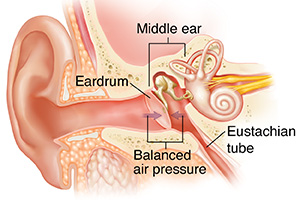Ears and Airplane Travel, Earwax, and Ear Cleaning
Ears and air travel
When many people travel by air, their ears may not pop as the altitude changes. This
is 1 of the most common health complaints of airplane passengers. It is caused by
an air pocket in the middle ear that is sensitive to changes in air pressure. The
changing altitude as the plane takes off or lands can cause mild pain in the ears.
Swallowing or yawning often can help "pop" the ears. This activates the muscle that
opens the eustachian tube. This tube connects the middle ear with the back of the
nose. Ears that are already blocked (by a cold, for example) can't equalize the air
pressure in the middle ear enough. This creates a vacuum that sucks the eardrum in
and stretches it. When the eardrum can't vibrate, sound is muffled. And the stretched
eardrum can be very painful. If you have nasal congestion from allergies, a cold,
or are prone to painful ears on airplane descent, then taking an over-the-counter
decongestant or antihistamine may help equalize the pressure in the ear. Talk to your
healthcare provider about which of these medicines are safe for you.

If swallowing or yawning does not ease the ears, try this ear-clearing method:
-
Breathe in through the mouth.
-
Pinch the nostrils shut and purse your lips closed.
-
Then exhale (while keeping nostrils and lips sealed). This will puff out your cheeks
and you should feel your eardrums pop.
If you hear a pop, your ears are unblocked. You may need to repeat this process a
few times, especially during the plane's descent before landing. After landing, if
your ears don't open and are still painful, see a healthcare provider who specializes
in ear problems.
Small children are more likely to have blocked ear canals. That's because their eustachian
tubes are narrower. Using a bottle or pacifier during take-off and landing may help
pop their ears. Try to keep small children awake during a descent so they will swallow
more often.
What is earwax?
Earwax is naturally made by the outer part of the ear canal to keep the ear clean.
It does this by trapping dust and sand particles before they reach the eardrum. It
entraps and kills bacteria, fungus, and viruses. Wax also coats the fragile skin of
the ear canal and acts as a water repellent. Wax buildup often moves its way to the
ear opening, dries up, and falls out.
How should I correctly clean my ears?
Normally, ears canals are self-cleaning. They should not need cleaning with any devices
or cotton-tipped swabs. Cleaning the ear can cause problems by pushing the earwax
deeper into the ear canal and against the eardrum. Sometimes, too much wax can build
up or can get pushed inwards. This will cause a blocked ear canal. In the case of
a blocked ear canal, see your healthcare provider. They may be able to do 1 or more
of the following:
-
Irrigate the ear canal to wash out the wax
-
Vacuum the ear canal with a special tool to remove the wax
-
Use other special tools to remove the wax
-
Use eardrops or mineral oil to soften the wax
Ear candles are not recommended. They have not been shown to work well and can cause
severe burns and burst (ruptured) eardrums.
Always see your healthcare provider for a diagnosis and for more information.